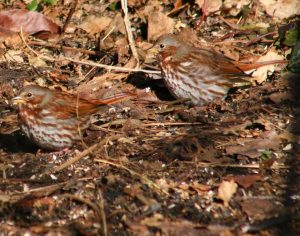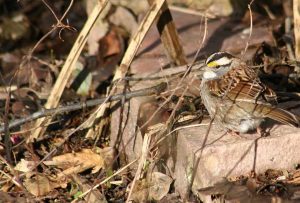Leave the Leaves
Think of fallen leaves as a blanket that conserves moisture, helps reduce erosion and flooding—and is essential to birds, butterflies and other species.


The trend in gardening for wildlife continues to expand in many parts of the country, particularly in the Northeast where inspired homeowners seek out native species to attract pollinators, birds, and other wildlife to their landscapes. Wildlife gardening gurus like Doug Tallamy and South Jersey’s own Pat Sutton continue to attract an avid base of followers looking for guidance on which plants and features work best to enhance their gardens as well as which sustainable practices they should implement.
Tallamy, with his research on how native plants, particularly trees, are critical in conserving birds and other wildlife, has created a blueprint for his “Homegrown National Park” Initiative. This project aims to convince homeowners to convert at least 50 percent of their chemical- and energy-hungry lawns into functional and sustainable ecosystems. His goal is a patchwork quilt of self-perpetuating landscapes that will help compensate for the lack of larger natural systems in densely settled regions of the country like the Northeast.
One of the emerging fronts in this effort centers around fallen leaves—how to think about them, and more importantly, what to do with them. Leaf litter is becoming a bit of a “hot topic” in natural gardening circles, but why should we “leave the leaves”? If we want our landscapes to mimic functioning natural systems, it is important to understand the role that fallen leaves serve in natural woodlands.
In nature it may take hundreds of years for a rich and living humus layer to form. In the forest, fallen leaves, with the help of bacteria and fungi, decompose and release nutrients like calcium, nitrogen, and sulphur back into the system to be recycled into the soil and to be made available to trees, understory shrubs, and herbaceous plants. This organic blanket helps to conserve moisture and to reduce erosion and flooding by retaining excess water and releasing it slowly back into the watershed.
The leaf layer also provides habitat for an amazing array of invertebrates like snails, slugs, worms, and arthropods such as insects and spiders, among many other orders of living things. These tiny organisms in turn serve as prey for vertebrates such as birds and small mammals, as well as for amphibians and reptiles. Many of our favorite butterflies require that leaf litter be left in place so that they can complete their lifecycles. Some diapause as eggs, some as pupae, and others as adults. The beautiful Mourning Cloak butterfly, which hibernates as an adult, may temporarily emerge from the leaf litter on mild winter days. Fritillaries, angle-wings, and hairstreak butterflies overwinter in leaf litter as eggs or as pupae.
Additionally, some of our iconic moths, including the beautiful Luna Moth, and woolly bear caterpillars depend on this habitat to ride out the harsh winter months safely. According to the National Wildlife Federation, some 94 percent of moth species rely on this leaf layer to complete their lifecycles.

Consequently, for many of our bird species, both migratory and year-round residents, fallen leaves are a prime resource in their search for insects and other invertebrates. Robins and hermit thrushes, towhees and sparrows, not to mention woodcocks, are among the many, many species dependent on this leaf litter ecosystem.
Through the work of researchers like Tallamy, it has been determined that close to 95 percent of bird species require the caterpillars of moths and butterflies to feed their young. All of this wildlife diversity is reliant on leaves being left in place.
Getting rid of your leaves by blowing, bagging, and landfilling them undermines your efforts to enhance your landscape’s biodiversity. So what are our options when it comes to fallen leaves? Instead of using polluting and noisy leaf blowers to get the leaves out of our yards, it is incumbent upon us to find ways of utilizing this amazing resource.
Try to use leaves as a mulch in your garden beds, preferably not shredding them, since shredding the leaves can serve to eliminate many of those tiny critters we are hoping to conserve. If possible, develop an area in your yard where you can have a leaf pile that is able to decompose at its own rate. You will find that this becomes the area where much of your wildlife will be concentrated.
If necessary you may shred the leaves and use them as a natural mulch around trees and other plantings. But don’t be overly concerned that a leaf layer will suppress your perennials, as many of our native plants are adapted to thrive in situations where fallen leaves are present.
Leaving the leaves can build up your soils, suppress unwanted weeds, conserve water, and insulate dormant plants from the desiccating winter air. Furthermore, leaves sent to a landfill have been shown to contribute considerably to greenhouse gases.
Don’t hesitate to seek out further guidance on this topic, online and on social media platforms. Being a part of the solution and not part of a problem will pay dividends, especially in the biodiversity you will be welcoming into your landscape.









